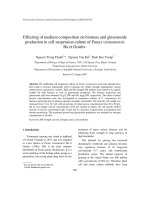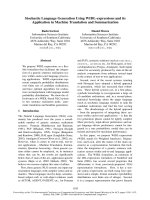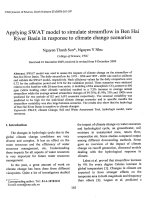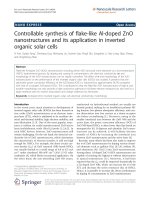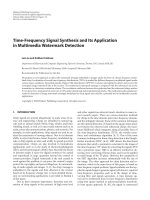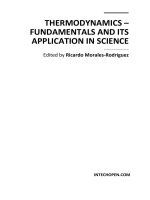Multi reanalysis data driven SWAT model building and its application in hydrology response to climate change in cau river basin of northern vietnam
Bạn đang xem bản rút gọn của tài liệu. Xem và tải ngay bản đầy đủ của tài liệu tại đây (5.4 MB, 150 trang )
分类号
----------
密 级
----------
U
------------
编 号
10486
D
C
博 士 学 位 论 文
基于多源再分析数据的 SWAT 模型构建及
其在越南北部 Cau 河流域水文对气候变化
的响应研究
研 究 生 姓 名 :DAO DUY MINH
指导教师姓名、
职称
陈晓玲 教授
:
陆建忠 副教授
学 科 、 专 业 名 称 :地图与地理信息系统
研
究
方
向 :遥感 GIS 应用;水文模型
二〇二二年五月
PhD Dissertation of Wuhan University
Multi reanalysis data-driven SWAT model building
and its application in hydrology response to climate
change in Cau river basin of northern Vietnam
By
DAO DUY MINH
Supervised by
Prof. Xiaoling Chen
A. Prof. Jianzhong Lu
Wuhan University
May, 2022
Multi reanalysis data-driven SWAT model building and its
application in hydrology response to climate change in
Cau river basin of northern Vietnam
By
DAO DUY MINH
Ph.D. Dissertation
Submitted to
State Key Laboratory of Information Engineering in Surveying,
Mapping and Remote Sensing (LIESMARS)
Of the
WUHAN UNIVERSITY
In partial Fulfillment of the Requirements for the Degree of
DOCTOR OF PHILOSOPHY
In
CARTOGRAPHY and GEOGRAPHIC INFORMATION SYSTEM
Prof. Xiaoling Chen
..................................................
A. Prof. Jianzhong Lu
.............................................
May, 2022
学位论文创新点 (INNOVATION)
本论文具有如下三个创新点:
(1) 探讨 CFSR 和 CMADS 数据用于越南北部 Cau 河流域水文气象研究的可能性
由于第 3 章的研究重点是评估水文研究中重新分析数据的可能性,因此本节保留了
GMS 控制模型中修正的参数,在 SWAT 模型中使用月尺度的 CMDAS 天气数据集(以下
简称 SWAT 模型,使用 CMADS 气象数据和校准的 GMS、SUC-CG 参数)。在校准(20092011)和验证(2012-2013)期间,利用 GCM、CMADS 和 SUC-CG 在 Gia Bay 水物站的模
拟结果对观测流量进行验证。根据每月时步的推荐性能评级记录结果为“良好”,
将评价指标采用 R2>0.8 和 NSE>0.7。这些指标的结果略优于使用常规的 CMADS 进行
校准, PBIAS 值达到-5.47 和-9.3% (相比之下,CMADS 分别为-16.19 和-19.35%)。
分析表明,与传统策略相比,该方法显著提高了模型的性能。如果对参数进行校准
以提高模型的性能,这种方法为水文研究重新分析数据的潜力提供了一种新的解决
方案。
(2) 气候预测的降尺度
第四章的研究重点是气候变化项目中全球尺度的气象数据降尺度到高分辨率局部尺
度数据。偏差校正空间分解方法 BCSD (Wood et al. 2004)被认为是最可靠、最有
效的方法之一,在世界许多地区的各种气候相关影响评估研究中被广泛采用。在本
研究中,我们首先对 BCSD 方法进行了详细的描述,以方便未来的用户,这在以前
的研究中没有很好的文献记录。将 BCSD 降尺度过程分为偏置校正(BC)和空间分解
(SD)两个主要阶段,将 GCM 数据从 1°× 1°的中间分辨率转化为 0.1°× 0.1°的
目标分辨率。据我们所知,这是在越南盆地研究中发现的最佳空间分辨率。
(3) 气候变化对 Cau 河流域水文过程的影响
CMADS 数据在访问、数据使用和在中国的研究中令人鼓舞的表现方面已被广泛使用,
并具有许多便利性。 我们的研究是在越南水文研究中引入该数据集的首次尝试。
此外,首次使用 GCM-CMIP6 数据对 CRB 上的温度、降水和径流变化进行的预测是
最新的,目前尚未广泛使用
附页二
论文原创性声明
本人郑重声明: 所呈交的学位论文, 是本人在导师指导下,独 立进行研究工
作所取得的研究成果。除文中已经标明引用的内容外, 本论文不包含任何其他个
人或集体已发表或撰写的研究成果。对本 文的研究做出贡献的个人和集体,均
已在文中以明确方式标明。本声明的法律结果由本人承担。
学位论文作者(签名) :DAO DUY MINH
2022 年 04 月 25 日
武汉大学博士学位论文
ABSTRACT
According to the Intergovernmental Panel on Climate Change (IPCC, 2013) the global
average surface temperature warmed by 0.85°C from 1880 to the 2012 year, causing changes
in precipitation and considerably impacting hydrological processes. Variations in temperature
and precipitation were found influential affect water yield, Evapotranspiration (ET), surface
runoff, the magnitude, and frequency of floods in the river basins. Therefore hydrological
models are developed to capture current hydrological processes as well as the associated effects
of climate change on the water resources is extremely important for prevention and mitigation
actions to be taken. The Soil Water Assessment Tool (SWAT), a semi-distributed model, was
developed to analyze the impacts of land use and climate changes on discharge, erosion,
sedimentation, and water quality in gauged and ungauged watersheds (Arnold et al., 1998).
SWAT has received international acceptance as a robust interdisciplinary catchment-scale
modeling tool because user-friendly nature, broad application capability, and the fact that is
well-evaluated, well-promoted, and well-supported.
Recent studies by the United Nations Environment Programme (UNEP) indicate that
Vietnam is one of the countries most affected by climate change with the air temperature will
increase by approximately 1,3 to 4°C by end of the 21st century. Under these circumstances,
water sources in rivers including the Cau river basin (CRB), a large river in northern Vietnam
may be adversely affected. Surprisingly, this area has only been recognized for studies in the
direction of assessing the current state of surface water quality. Therefore, a thorough
understanding of the current status and changing trends of hydrological processes under
changing climate conditions in the CRB for developing sustainable water resources
management in the state.
Investigating the possibility of CFSR and CMADS data in hydrometeorological
studies in the Cau river basin, Northern Vietnam
In Chapter Three, the potential application of two GCPs, the China Meteorological
Assimilation Driving Datasets for the SWAT model (CMADS) and Climate Forecast System
Reanalysis (NECP-CFSR), are compared for the first time with data from ground-based
meteorological stations over the CRB, northern Vietnam. These products are used because they
have higher spatial resolutions than other products and are openly available for the study areas,
covering both temperature and precipitation, and can be used immediately in flow simulations.
This is a major advantage of CFSR and CMADS over satellite precipitation data that often lack
associated temperature data and heterogeneous time scales.
Major input data for SWAT include DEM, LULC, soil properties, and daily weather
data (includes grid points and ground measurement stations located around or covering the
catchment area). The period for collection and processing from 1 January 2008 to 31 December
2013 to ensure consistency in the evaluation and comparison of the performances of the input
data. The 2012 ArcSWAT version, an interface in ArcGIS used to perform simulations
i
Multi reanalysis data-driven SWAT model building and its application in hydrology response
to climate change in Cau river basin of northern Vietnam
controlled by CFSR_, CMADS_, and GMS_. The lack of gauge stations is a major issue in
different parts of the world, including the CRB. Besides, some uncertainties may arise during
interpolation of measuring stations with grid-based monitoring data, so the evaluation is limited
between grids containing corresponding measured observed values. Hence, the climate aspect
comparison was conducted using the point-to-grid approach, where the gauge stations were
directly compared to their respective grids’ values.
The mean CC value of Tmax and Tmin obtained from CFSR is > 0.92, while that of
CMADS is > 0.96. In addition, the MAE ranged from 0.95 to 2.47, and the RMSE varied from
1.27 to 2.85 indicating that the GCPs are in good agreement with the temperature variation at
the observation stations. Although the negative PBIAS value at most stations reflects that both
the CFSR and CMADS data tend to underestimate the Tmax and Tmin temperatures but CFSR
and CMADS can be used as an alternative to GMS in the CRB hydrometeorological studies. A
difference is found in that the CMADS values underestimated the actual precipitation, with a
PBIAS value of -16.64%, while CFSR overestimated with a PBIAS of 99.2%. Therefore, the
MAE value of CMADS was much lower than that of CFSR, 5.7 and 8.01 mm/day, respectively.
Furthermore, the analysis results of the seasonal statistical indicators obtained from the CFSR
data show the largest mean errors, with MAE and RMSE values that are too large. As expected,
at the pixel scale in the basin, the CFSR rainfall data was overestimated over most of the basin,
with a prevalence value between 60% and 150%. In contrast, the rainfall data of CMADS tends
to underestimate with an average PBIAS of -16%, but the data exhibit different states rainfall
is underestimated in the western mountains the while the data have slightly higher ratings in the
southern plains.
In areas with tropical climates such as the Cau river, rainfall is the major source and
greatly affects the runoff simulation results. The analysis showed that the rainfall data obtained
from GMS and CMADS reached an agreement better than the agreement between CFSR and
GMS. In general, the SWAT model based on the GMS data is best suited during the calibration
and validation periods at both daily and monthly scales. The simulated flow reproduced by
SWAT_GMS at Gia Bay station is “Good”, with NSE> 0.79 and R2>0.68. The simulations
performed using the SWAT_CMADS tend to underestimate the observed flow, with PBIAS
values varying from -16.19 to -19.35%, but with R2> 0.76 and NSE> 0.78; thus, flow
simulations performed by CMADS data were within "satisfactory" on the monthly scale
according to the given criteria. Finally, the SWAT_CFSR is not suitable for flow simulations
over the CRB basin with, R2 and NSE values that are "Unsatisfactory" based on the given
criteria. Some studies have also found that integrating temperature data from CFRS with the
precipitation data of the other GCPs did not cause any difference compared to conventional
simulations mainly because these data overestimate the actual precipitation values.
Because the research focus of Chapter 3 is to evaluate the possibility of re-analytical
data in hydrological studies, in this section the parameters corrected in the GMS control model
are preserved, and use CMDAS weather dataset in the SWAT model on a monthly scale
(hereinafter referred to as SWAT model Using CMADS's meteorological data and Calibrated
ii
武汉大学博士学位论文
parameters of GMS, SUC-CG). The observed flow was used for validation with simulation
results by GCM, CMADS, and SUC-CG at Gia Bay hydrological station during calibration
(2009-2011) and validation (2012-2013) period. The evaluation indicators with R2 value > 0.8,
while NSE > 0.7 records result as “good” by the recommended performance rating for the
monthly time step. These indicators show slightly better results than using calibration by
conventional CMADS with PBIAS values reaching -5.47 and -9.3% (compare to -16.19 and 19.35% for CMADS, respectively). The flow tends to peak in August, which is consistent with
the rainiest times of the year for GMS, CMADS, and even SUC-CG. However, simulation
results from SUC-CG reproduce better at peak flows and degradation phases than CMADS.
The obtained flow curves are closer to the hydrological station than the CMADS in the flood
season (May to October) showing SUC-CG can get better results than conventional CMADS
simulations. Despite the same tendency to underestimate the actual flow as SWAT_CMADS
but SWAT_SUC-CG has a better PBIAS value. The analyzes have shown that this method has
significantly improved the performance of the model compared with the conventional strategy.
This approach provides an additional new solution to the potential of reanalyzed data for
hydrological studies if the parameters are calibrated to improve the performance of the model.
If the model input, especially the precipitation variable, is verified before application in
hydrological studies (e.g. CFSR) it gives the modeler confidence in the model outputs.
Projections of Future Climate Change over the Cau river basin Using the BCSD
Downscaling Method
Downscaling from global-scale meteorological data to high-resolution local-scale data
in climate change projects is the research focus of Chapter Four. Global climate models
(GCMs) are robust tools for quantitatively assessing climate change impacts. However, GCMs
outputs are insufficient to provide accurate information for local to regional scale needs due to
their inadequately coarse horizontal resolutions (typically at 100-300 km). The Bias Correction
Spatial Disaggregation method, BCSD (Wood et al. 2004) is widely used in climate-related
impact assessment studies throughout the world and is regarded as one of the most trustworthy
and successful methodologies. In this study, we first present a detailed description of the BCSD
method for the convenience of future users, which has not been well documented in previous
research.
Firstly, the observed station data were interpolated to a 0.1° x 0.1° gridded dataset
(hereinafter called OBS) by using the interpolation techniques for T2m (mean temperatures),
daily Tmax, Tmin, and rainfall. The newly-created gridded OBS dataset will be used further in
this study to bias-correct GCM data and to estimate future climate patterns in the CRB. Then,
The BCSD downscaling process was divided into two major stages, namely Bias Correction
(BC) and Spatial Disaggregation (SD), to spatially translate GCM data from the intermediate
resolution of 1° × 1° to the targeted high-resolution of 0.1° × 0.1°. To our knowledge, this is
the best spatial resolution found in a study of a basin in Vietnam.
iii
Multi reanalysis data-driven SWAT model building and its application in hydrology response
to climate change in Cau river basin of northern Vietnam
The correlation of 5 representative GCMs (including CNRM-ESM2-1, EC-Earth3,
GFDL-ESM4, HadGEM-GC31-LL, MPI-ESM1-2-HR) is downscaled with meter-based data
in the CRB for the period 1985-2014. Based on the locations of all points on the scatter plot, it
can be seen that BCSD produces similar monthly mean temperature and mean monthly
precipitation outputs at all GCMs at the observation station in the basin. The accuracy of the
GCMs with CC is mostly greater than 0.99 for both T2m, Tmax and Tmin. The correlation
results of cumulative monthly observed precipitation (mm/day) and GCMs data show values in
the range of 0.994 to 0.998 during this period. Dimensional and dimensionless measures are
also recommended in this study to evaluate the performance of the model these results suggest
that the statistics are within the reasonable range between representative GCM models and
observation stations. Besides, the calculation results from a refined index of agreement (dr),
indicate that the value of the BCSD model error, represented by MAE, is lower than the mean,
implying that BCSD values can be reasonably used in the input of future climate/hydrology
scenarios.
Future scenarios are downgraded for climate variables (precipitation, T2m, Tmax, and
Tmin) to detect the general trend for the period 1985-2100 in the CRB. Accordingly, a profound
warming trend is recorded with the annual average Tmax and Tmin both increasing at all future
meteorological stations and consistent with the increasing trend in average temperature. At the
end of this century, SSP5-8.5 makes the worst assumption with increases in Tmax and Tmin of
3.3oC and 3.2oC respectively, significantly higher than the scenario SSP2-4.5. With regard to
precipitation, the results showed an increasing trend at all SSPs in the near-future (the 2030s)
and mid-future (the 2060s); while SSP5-8.5 showed the opposite trend with the decline of
average annual rainfall in the distant future period (the 2080s). In general, these outcomes imply
that the CRB is likely to be hotter in future periods, which may cause potential issues relating
to agricultural activities and water consumption.
Impacts of Climate Change on Hydrology Processes in the Cau river basin
The projected changes in climate will have direct and indirect effects on the natural
environment as well as on human society, especially on hydrology and water resources. In
Chapter Five, we introduce a quantitative assessment of the changes in the flow regime of the
CRB under climate change impacts. First, historical streamflow on the basin was simulated
from topography, land cover, soil, and ground weather observations by the SWAT model.
Second, project streamflow on the basin by inputting climate change data under SSP scenarios
over the twenty-first century into a well-validated SWAT model. Finally, differences in flow
regime between climate change scenarios and baseline period were analyzed.
The calculation results of the water balance in climate change scenarios show that
precipitation will increase (2-12%), while ET will decrease (2-7%), leading to an increase in
runoff (9-34%) compared to the baseline period (1997-2013). In terms of precipitation, climate
projections in both scenarios SSP2.45 and 5.85 show a significant upward trend in the middle
of the dry season or the wet season while the decreasing trend of rainfall occurs mainly at the
iv
武汉大学博士学位论文
beginning of the dry season (December) or the end of the dry season (April) or the beginning
of the wet season (May). The values of ET are identical with an upward trend dominating,
except for a decrease at the end of the dry season and the first half of the wet season. For water
yield, the flow in the future tends to increase in both wet and dry seasons. Flow may decrease
at the end of the dry season (April) and the beginning of the wet season (May).
The discharge at the basin outlet in all scenarios will increase from 6 to 53% compared
to the baseline. For the SSP2-4.5 scenario, the increased rate of streamflow is higher in the rainy
season than in the dry season in the short and medium-term. However, this value is stronger in
the dry season than in the rainy season in the long term. For the SSP5-8.5 scenario, streamflow
acceleration is higher in the dry season than in the rainy season in all three periods of this
century. Annual flow tends to increase more strongly in two periods 2021-40 and 2041-60 than
in the 2080-99 period. On the other hand, the impact of climate change will make streamflow
higher in most of the dry season (from November to March of the following year), and the rainy
season (July-October). However, the flow projections during the transition period between the
dry and wet seasons (April - June) are heterogeneous.
Prediction of runoff, as well as extreme flow, is important for water management in the
CRB. Accordingly, The changes in the high flow (Q5) under SSP2-4.5 showed an increasing
tendency in three time periods (2021–40, 2041-60, and 2080–99) whereas, in the SSP5-8.5
scenario the high flow increases in the short term but decreases in the medium term and the
long term. For the low flow (Q95), the predicted value will decrease in the middle period for
SSP2-4.5 and the last period under SSP5-8.5. The final content of this chapter covers the annual
mean of surface runoff, soil water content, and ET at the sub-basin scale under SSPs over three
periods (2021–2040, 2041-60, and 2080-99). Whereby, surface runoff increases in most of the
sub-basins according to SSP2-4.5, especially in the upstream and midstream regions of the
basin in the two periods 2021-2040 and 2041-2060. But it decreased in all sub-basins during
this century according to SSP5-8.5. Soil water content and ET are projected to increase in most
sub-basins under climate change scenarios. However, the rate of rising of the two water balance
components will higher in SSP5-8.5 than in SSP2-4.5.
Conclusion
Generally, the results obtained are very encouraging, showing that hydrological
processes in the Cau river have benefited from the SWAT model. The findings of this study can
assist water resource managers in making informed water use decisions, creating public policies
that support appropriate use, in applying mitigation and prevention measures, to ensure water
security in the basin and agronomically similar basins.
Keywords: Cau river basin, SWAT model, CFSR, CMADS, CMIP6, BCSD method,
streamflow, downscale, climate change
v
Multi reanalysis data-driven SWAT model building and its application in hydrology response
to climate change in Cau river basin of northern Vietnam
摘要
根据政府间气候变化专门委员会(IPCC, 2013)的数据,从 1880 年到 2012 年,全
球地表的平均温度升高了 0.85°C,导致降水发生变化,并对水文过程产生了重大影响。
研究发现,温度和降水的变化会影响流域的出水量、蒸散发(ET)、地表径流以及洪水
的规模和频率。因此,建立水文模型以捕捉当前的水文过程并评估气候变化对水资源
的影响对于预防和减轻这部分影响有着极为重要的意义。土壤水分评估工具(SWAT)是
一种半分布模型,常被用于分析土地利用和气候变化对流域的流量、侵蚀、泥沙和水
质的影响(Arnold et al., 1998)。SWAT 作为一种强大的跨学科流域规模的建模工具,因
其具有对用户友好的特性、广泛的应用能力,以及得到了良好的评估、推广和支持,
已经得到了国际上广泛的认可。
联合国环境规划署(UNEP)最近的研究表明,越南是受气候变化影响最严重的国
家之一,到 21 世纪末,越南的气温将上升约 1.3 至 4°C。在这种情况下,包括 Cau 河
流域(CRB)在内河流的水源可能会受到负面的影响。Cau 河流域是越南北部的一条大河。
令人惊讶的是,这一区域只在评估地表水水质现状的研究中才受到关注。因此,需要
深入了解气候变化条件下 Cau 河流域水文过程的现状和变化趋势,为开展 Cau 河流域
状态的可持续水资源管理提供依据。
探讨 CFSR 和 CMADS 数据用于越南北部 Cau 河流域水文气象研究的可能性
在第三章中,本文首次将 SWAT 模型和气候预报系统再分析(NECP-CFSR)下的
中国气象同化驱动数据集(CMADS)这两种潜在的 GCP 与越南北部 CRB 的地面气象站
数据进行了比较。之所以使用这些产品,是因为它们比其他产品具有更高的空间分辨
率,且数据在研究区域内是公开的,它们包含了温度和降水数据,并可立即用于径流
模拟。这是 CFSR 和 CMADS 相对于缺乏相关温度数据和非均匀时间尺度的卫星降水数
据的一个主要优势。
SWAT 的主要输入数据包括 DEM、LULC、土壤属性和每日天气数据(包括位于
集水区周围或覆盖集水区的格网和地面测量站)。为了确保输入数据性能评价和比较的
一致性,本研究收集和处理了 2008 年 1 月 1 日至 2013 年 12 月 31 日间的数据。本研究
使用 2012 版 ArcSWAT——ArcGIS 中的一个接口来执行由 CFSR_、CMADS_和 GMS_
控制的模拟。测站数据的缺乏是世界各地的一个主要问题,包括 CRB。此外,基于网
格监测数据的测站插值过程中可能存在一定的不确定性,因此评价仅限于包含在相应
实测观测值的网格之间。因此,采用点到格网的方法进行气候方面的比较,在这种方
法中,测量站直接与各自格网的值进行比较。
由 CFSR 得到的 Tmax 和 Tmin 的 CC 均值>0.92, 与此同时,CMADS>0.96。此外,
MAE 在 0.95 ~ 2.47 之间,RMSE 在 1.27 ~ 2.85 之间,这表明 GCPs 与观测站温度变化
vi
武汉大学博士学位论文
的一致性较好。虽然大多数台站的 PBIAS 为负值——这表明 CFSR 和 CMADS 数据都
有低估 Tmax 和 Tmin 的倾向,但 CFSR 和 CMADS 在 CRB 水文气象研究中为替代 GMS
提供了可能。两者的差异在于,CMADS 低估了实际降水,PBIAS 为-16.64%,而 CFSR
高估了实际降水,PBIAS 为 99.2%。因此,CMADS 的 MAE 值远低于 CFSR,分别为
5.7 mm/d 和 8.01 mm/d。此外,从 CFSR 数据得到的季节统计指标的分析结果显示,平
均误差最大,MAE 和 RMSE 值都过大。正如预期的那样,在流域的像素尺度上,CFSR
降水数据在大部分流域被高估,普遍值在 60%到 150%之间。相比之下,CMADS 的降
水数据往往低估,平均 PBIAS 为-16%,但数据显示西部山区不同州的降水被低估,而
在南部平原则略高。
在热带气候地区,如 Cau 河,降雨是径流量的主要来源,极大地影响其模拟结
果。分析表明,GMS 和 CMADS 的降水数据比 CFSR 和 GMS 的降水数据具有更好的一
致性。一般来说,基于 GMS 数据的 SWAT 模型在每日和每月的校准和验证期间最为适
合。SWAT_GMS 在 Gia Bay 站模拟的流场效果为“良好”,NSE>0.79,R2>0.68。使用
SWAT_CMADS 进行的模拟往往会低估观测到的流量,PBIAS 值在-16.19%到-19.35%之
间,但 R2>0.76,NSE>0.78。因此,根据给定的标准,用 CMADS 数据进行的流动模拟
在月尺度上是“令人满意的”。最后,SWAT_CFSR 不适合 CRB 盆地的流动模拟,根
据给定的标准,R2 和 NSE 值“不令人满意”。一些研究还发现,与常规模拟相比,将
CFRS 的温度数据与其他 GMP 的降水数据相结合不会造成任何差异,主要是因为这些
数据高估了实际降水值。
由于第 3 章的研究重点是评估水文研究中重新分析数据的可能性,因此本节保留
了 GMS 控制模型中修正的参数,在 SWAT 模型中使用月尺度的 CMDAS 天气数据集
(以下简称 SWAT 模型,使用 CMADS 气象数据和校准的 GMS、SUC-CG 参数)。在校
准(2009-2011)和验证(2012-2013)期间,利用 GCM、CMADS 和 SUC-CG 在 Gia Bay 水
物站的模拟结果对观测流量进行验证。根据每月时步的推荐性能评级记录结果为“良
好”,将评价指标采用 R2>0.8 和 NSE>0.7。这些指标的结果略优于使用常规的 CMADS
进行校准, PBIAS 值达到-5.47 和-9.3% (相比之下,CMADS 分别为-16.19 和-19.35%)。
流量在 8 月达到峰值,这与 GMS、CMADS 甚至是 SUC-CG 一年中降雨量最多的时期
一致。然而,在流量的峰值和退化阶段,SUC-CG 的模拟结果比 CMADS 更好。汛期(5
~ 10 月)的流量曲线比 CMADS 更接近水文站,表明 SUC-CG 模拟的结果优于常规
CMADS 模拟。尽管与 SWAT_CMADS 一样有低估实际流量的倾向,但 SWAT_SUCCG 有更好的 PBIAS 值。分析表明,与传统策略相比,该方法显著提高了模型的性能。
如果对参数进行校准以提高模型的性能,这种方法为水文研究重新分析数据的潜力提
供了一种新的解决方案。如果模型输入,特别是降水变量,在应用于水文研究(如
CFSR)之前得到验证,则会使建模者对模型输出更有信心。
vii
Multi reanalysis data-driven SWAT model building and its application in hydrology response
to climate change in Cau river basin of northern Vietnam
气候预测的降尺度
第四章的研究重点是气候变化项目中全球尺度的气象数据降尺度到高分辨率局
部尺度数据。全球气候模型(GCMs)是定量评估气候变化影响的有力工具。然而,由于
GCM 的粗水平分辨率(通常在 100-300 公里)不足,其产出不足以为地方到区域尺度的需
要提供准确的信息。偏差校正空间分解方法 BCSD (Wood et al. 2004)被认为是最可靠、
最有效的方法之一,在世界许多地区的各种气候相关影响评估研究中被广泛采用。在
本研究中,我们首先对 BCSD 方法进行了详细的描述,以方便未来的用户,这在以前
的研究中没有很好的文献记录。
首先,通过基于 T2m、日 Tmax、Tmin 和降雨量数据,将观测台站数据插值到
0.1°x 0.1°的网格数据集(以下简称 OBS)。新创建的网格化 OBS 数据集将在本研究中进
一步用于校正 GCM 数据的偏差,并在 CRB 中估计未来的气候模式。然后,将 BCSD
降尺度过程分为偏置校正(BC)和空间分解(SD)两个主要阶段,将 GCM 数据从 1°× 1°的
中间分辨率转化为 0.1°× 0.1°的目标分辨率。
利用 1985-2014 年地球观测资料,对 5 个代表性的大气环流模式(CNRM-ESM21、EC-Earth3、GFDL-ESM4、HadGEM-GC31-LL、MPI-ESM1-2-HR)进行了降尺度。
从散点图中可以看出,BCSD 在该流域观测站所有 GCM 的月平均温度和月平均降水输
出是相似的 T2m、Tmax 和 Tmin 的精度大多高于 0.99。月累计观测降水(mm/day)与
GCMs 数据的相关性在 0.994 ~ 0.998 之间。本文还建议采用量纲测度和无量纲测度来评
价模型的性能,结果表明模型与观测站的统计量在合理范围内。此外,根据改进的一
致性指数(dr)的计算结果表明,以 MAE 为代表的 BCSD 模型误差低于平均值,表明
BCSD 值可以合理地用于未来气候/水文情景的输入。
对气候变量(降水、T2m、Tmax 和 Tmin)的未来情景进行降级,以检测 CRB 中
1985-2100 年期间的总体趋势。未来所有气象站的年平均 Tmax 和 Tmin 均有所增加,并
与平均气温的增加趋势一致,呈现出明显的变暖趋势。在本世纪末,SSP5-8.5 情景最
为糟糕,Tmax 和 Tmin 分别增加 3.3℃和 3.2℃,显著高于 SSP2-4.5 情景。降水方面,
近期(2030 年代)和中期(2060 年代)的 SPS 均呈增加趋势;而 SSP5-8.5 在遥远的未来期
(2080 年代),随着年均降水量的减少呈现相反的趋势。总的来说,这些结果意味着
CRB 在未来时期可能会更热,这可能会导致与农业活动和用水有关的潜在问题。
气候变化对 Cau 河流域水文过程的影响
预测的气候变化将对自然环境和人类社会产生直接和间接的影响,特别是对水
文和水资源。在第五章中,我们介绍了气候变化影响下 CRB 流态变化的定量评估。首
先,利用 SWAT 模型根据地形、土地覆盖、土壤和地面天气观测数据模拟流域的历史
径流。其次,通过将 21 世纪 SSP 情景下的气候变化数据输入到一个经过充分验证的
viii
武汉大学博士学位论文
SWAT 模型中来预测流域的流量。最后,分析了气候变化情景与基线期之间的流态差
异。
气候变化情景下的水平衡计算结果表明,与基线期(1997-2013 年)相比,降水将
增 加(2-12%),ET 将 减少 (2-7%),导致径 流量增加 (9-34%)。降 水 、气候预测 情 景
SSP2.45 和 5.85 在旱季和雨季显示显著的上升趋势,降雨量的减少趋势主要发生在旱季
(12 月)的开始、旱季的结束(4 月)或雨季的开始(5 月)。ET 值则基本保持一致,除枯水期
末和雨季上半期出现下降外,均以上升趋势为主。就产水量而言,未来的流量在雨季
和旱季都趋于增加。在旱季结束(4 月)和雨季开始(5 月),流量可能会减少。
与基线相比,在所有情景中,流域出口处的流量将从 6%增加到 53%。对于
SSP245 情景,在中短期内,雨季的径流增加速率高于旱季。然而,从长期来看,旱季
的这一数值要高于雨季。对于 SSP585 情景,在本世纪的所有三个时期,旱季的径流加
速都高于雨季。与 2080-99 年相比,2021-40 年和 2041-60 年期间的年流量增长更为强
劲。另一方面,气候变化的影响会使旱季(11 月至次年 3 月)和雨季(7 - 10 月)的径流增
加。旱季和雨季(4 - 6 月)过渡期间的流量预测是不一致的。
径流和极端流量的预测对于 CRB 的水资源管理非常重要。因此,在 SSP245 情
景下,高流量(Q5)的变化在三个时间段(2021-40 年、2041-60 年和 2080-99 年)呈现增加
趋势,而在 SSP585 情景下,高流量在短期内增加,但在中长期内减少。对于小流量
(Q95), SSP245 的中间时段和 SSP585 的最后时段预测值会降低。本章的最终内容包括
三个时段(2021-2040 年、2041-60 年和 2080-99 年)SSPs 下的子流域尺度的年平均地表径
流、土壤水分和 ET。根据 SSP245 分析,大部分子流域的地表径流均呈增加趋势,特
别是在 2021-2040 年和 2041-2060 年两个时段,流域上游和中游区域的地表径流均呈增
加趋势。但根据 SSP585 的数据,本世纪以来各子盆地均呈下降趋势。在气候变化情景
下,大部分子流域土壤水分和蒸散量均呈增加趋势。而 SSP585 的两种水分平衡组分的
上升速率高于 SSP245。
结论
总的来说,本研究得到的结果是令人鼓舞的,它表明 Cau 河的水文过程适用于
SWAT 模型。这项研究的结果可以帮助水资源管理者做出有益的用水决策,制定用水
的公共政策以保障必要的使用,实施缓解和预防措施,以确保该流域和农业条件类似
流域的水安全。
关键词: Cau 河流域、SWAT 模型、CFSR、CMADS、CMIP6、BCSD 方法、径流、降
尺度、气候变化
ix
Multi reanalysis data-driven SWAT model building and its application in hydrology response
to climate change in Cau river basin of northern Vietnam
TABLE AND CONTENTS
ABSTRACT ................................................................................................................................ i
摘要 ........................................................................................................................................... vi
TABLE AND CONTENTS ........................................................................................................ x
LIST OF FIGURES .................................................................................................................xiii
LIST OF TABLES .................................................................................................................. xvi
LIST OF ACRONYMS AND ABBREVIATIONS ............................................................... xvii
Chapter One: Introduction ...................................................................................................... 2
1.1 Backgrounds ......................................................................................................................... 2
1.2 Problem Statement................................................................................................................ 4
1.3 Research Objectives ............................................................................................................. 5
1.4 Thesis Organization .............................................................................................................. 6
Chapter Two: Literature Review and Data Sources ............................................................. 9
2.1 Introduction .......................................................................................................................... 9
2.2 Hydrological cycle and review of Vietnam’s water resources ............................................. 9
2.2.1 Hydrological Cycle Review ........................................................................................... 9
2.2.2 Catchment Hydrology .................................................................................................. 11
2.3 Catchment Hydrologic Modelling ...................................................................................... 12
2.3.1 Importance of Hydrologic Models ............................................................................... 12
2.3.2 Hydrologic Modeling ................................................................................................... 12
2.3.3 Why did choose SWAT Applications in Hydrologic Assessment in the CRB? .......... 14
2.4 The Soil and Water Assessment Tool (SWAT) Model ...................................................... 15
2.4.1 General Description of The Model .............................................................................. 15
2.4.2 Modeling Approach and Structure ............................................................................... 16
2.4.3 Model Calibration and Uncertainty Analysis .............................................................. 18
2.4.4 Overview of alternative climate products for SWAT modelling ................................. 20
2.5 Future Climate Model......................................................................................................... 22
2.5.1 Climate Change Impacts on Hydrology....................................................................... 22
2.5.1.1 ET .......................................................................................................................... 23
2.5.1.2 Surface Runoff ...................................................................................................... 23
2.5.1.3 Streamflow and Flood ........................................................................................... 24
2.5.2 Future Emissions Scenarios for Climate Changes ....................................................... 24
2.5.2.1 Overview of climate models ................................................................................. 24
2.5.2.2 CMIP6 and Future emission scenarios. ................................................................. 25
x
武汉大学博士学位论文
2.6 Study Area and Data Source for SWAT Model ................................................................. 27
2.6.1 Description of the study area ....................................................................................... 27
2.6.2 SWAT Model Input for the CRB ................................................................................. 28
2.6.2.1 Digital Elevation Model (DEM) ........................................................................... 28
2.6.2.2 Land use/land cover data ....................................................................................... 28
2.6.2.3 Climatic and Hydrological Data ............................................................................ 29
2.7 Conclusion .......................................................................................................................... 31
Chapter Three: StreamFlow Simulation used CFSR and CMADS Data ......................... 33
3.1 Introduction ........................................................................................................................ 34
3.2 Materials and methods ........................................................................................................ 36
3.2.1 Location of the study area ............................................................................................ 36
3.2.2. Model input data ......................................................................................................... 37
3.2.2.1 Digital Elevation Model (DEM) ........................................................................... 37
3.2.2.2 Soil type and characteristics .................................................................................. 38
3.2.2.3 Reanalysis datasets ................................................................................................ 38
3.2.2.4 GMS Data .............................................................................................................. 39
3.2.3 Model calibration, validation and sensitivity analysis ................................................. 41
3.2.3.1 The calibration method and approach ................................................................... 41
3.2.3.2 Uncertainty and model performance indices ......................................................... 41
3.2.4 Evaluation indicators ................................................................................................... 42
3.2.4.1 Index evaluates temperature and precipitation ...................................................... 42
3.2.4.2 Flow indicators ...................................................................................................... 43
3.3 Results and Discussions ..................................................................................................... 45
3.3.1 Temperature/Precipitation validation........................................................................... 45
3.3.1.1 Compare CFSR and CMADS temperatures using GMS data ............................... 45
3.3.1.2 Temporal distribution of Precipitation .................................................................. 47
3.3.1.3 Comparison in the spatial scale (pixels)................................................................ 48
3.3.2 Precision of precipitation event detection .................................................................... 50
3.3.3 Evaluate the ability to capture extreme weather events ............................................... 51
3.3.4 Parameter sensitivity analysis and calibration ............................................................. 54
3.3.5 Peformance of simulate streamflow............................................................................. 55
3.3.6 Calibration and validation of the SWAT model against parameters calibrated from
GMS and CMDAS weather data .......................................................................................... 57
3.3.7 Discussion .................................................................................................................... 59
3.4 Conclusion .......................................................................................................................... 62
xi
Multi reanalysis data-driven SWAT model building and its application in hydrology response
to climate change in Cau river basin of northern Vietnam
Chapter Four: Projections of Future Climate Change over the Cau river basin Using the
BCSD Downscaling Method .................................................................................................. 64
4.1 Introduction ........................................................................................................................ 64
4.2 Data and methods ............................................................................................................... 66
4.2.1 Study area and Data Sources ....................................................................................... 66
4.2.2 The BCSD approach .................................................................................................... 69
4.2.3 Additive and Multiplicative Methods of Change Factors ............................................ 71
4.2.4 The Innovative-Şen Trend Analysis Method ............................................................... 72
4.2.5 Evaluation of Model Performance ............................................................................... 73
4.3 Results and Discussions ..................................................................................................... 74
4.3.1 Correlation between GCMs and Data Observed In Situ .............................................. 74
4.3.2 Future changes in annual precipitation and temperature ............................................. 77
4.3.3 Changes in Future Seasonal Maximum/Minimum Temperature and Precipitation..... 81
Chapter Five: Impacts of Climate Change on Hydrology Processes in Cau river basin 87
5.1 Introduction ........................................................................................................................ 87
5.2 Material and Methods ......................................................................................................... 88
5.2.1 Study area .................................................................................................................... 88
5.2.2 SWAT model ............................................................................................................... 89
5.2.3 Input Data .................................................................................................................... 90
5.2.4 Methodology ................................................................................................................ 93
5.3 Results and Discussions ..................................................................................................... 94
5.3.1 Model calibration and validation ................................................................................. 94
5.3.2 Impact of climate change on flow regime ................................................................... 96
5.3.2.1 Water balance components.................................................................................... 96
5.3.2.2 Streamflow and surface runoff .............................................................................. 98
5.3.2.3 Peak flows ............................................................................................................. 99
5.3.2.4 Hydrological extremes ........................................................................................ 100
5.3.3 Impact of climate change on sub-basin scale hydrology ........................................... 102
5.4 Conclusion ........................................................................................................................ 104
Chapter Six: Conclusions and Recommendations............................................................. 107
6.1 Conclusions ...................................................................................................................... 107
6.2 Thesis New Findings ........................................................................................................ 109
6.3 Recommentdations and Future Work ............................................................................... 110
BIBLIOGRAPHY ................................................................................................................. 113
PUBLICATIONS .................................................................................................................. 124
xii
武汉大学博士学位论文
LIST OF FIGURES
Figure 1.1: Framework of the research: (a) Present input data; (b) Future input data; (c)
Process in the SWAT model, and (d) Simulation results ........................................... 7
Figure 2.1: Pictorial representation of hydrological cycle (Source: ,
accessed on 25/03/2022) ............................................................................................ 10
Figure 2.2: Classification of hydrological models (Source: Singh, 1988; Xu, 2002) ..
.................................................................................................................................... 14
Figure 2.3: Components of the hydrologic balance of the SWAT model (Adapted from
Arnold et al., 1998)..................................................................................................... 16
Figure 2.4: Schematic respresentation of a HRU hydrologic cycle (Source: Neisch et al.,
2001) ........................................................................................................................... 17
Figure 2.5: SWAT Model Components and Inputs (Modified from Neitsch et al., 2002)
.................................................................................................................................... 18
Figure 2.6: Shared Socieconomic Pathways and CMIP6 Scenarios ............................ 26
Figure 2.7: CMIP6 includes future CO2 emission scenarios as well as historical CO2
emissions .. ................................................................................................................. 26
Figure 2.8: Study region map of the CRB: (a) Digital elevation model (DEM) and
monitoring networks, (b) Land use map .................................................................... 29
Figure 2.9: Conceptual framework of SWAT model and its setup .............................. 30
Figure 3.1: Study region map of the Cau River Basin: (a) digital elevation model (DEM)
and (b) land use map .................................................................................................. 40
Figyre 3.2: Box plots of daily maximum (a-d) and minimum (e-h) temperatures from
CFSR and CMADS at the BacKan, DinhHoa, ThaiNguyen and BacNinh
meteorological stations .............................................................................................. 46
Figure 3.3: Spatial distributions of the correlation coefficient (CC) on the daily (a-b) and
monthly (c-d) scales and of MAE (mm/month) (e-f) and PBIAS (%) (g-h) on the
monthly scale in the Cau River basin over the period from 2008-2013 .................... 49
Figure 3.4: Occurrence frequencies (a) and relative contributions (b) of daily-scale
rainfall thresholds obtained from the CFSR, CMADS and GMS data for the period
2008-2013 ................................................................................................................... 51
Figure 3.5: Number of days when hot weather occurred in the period 2008-2013...... 54
Figure 3.6: Observed streamflow and simulations performed using the GMS-, CFSR-,
and CMADS-driven models at the daily scale over the CRB .................................... 56
Figure 3.7: Observed streamflow and simulations obtained using the GMS-, CFSR-, and
CMADS-driven models at the monthly scale over the CRB ..................................... 57
xiii
Multi reanalysis data-driven SWAT model building and its application in hydrology response
to climate change in Cau river basin of northern Vietnam
Figure 3.8: Calibration (1981-1992) and validation (1993-2002) of the SWAT model
with simulations based on ground-based meteorological stations (GMS) and models
controlled by CMADS and SCU-CG (SWAT model using CMADS's meteological
data and Calibtrated parameters of GMS) uses monthly observed flow at Gia Bay
hydrological station .........................................................................................................58
Figure 4.1 Geographical location of the CRB and meteorological stations collected data
Tmax, Tmin and rainfall ............................................................................................. 67
Figure 4.2 The maijor steps of BCSD downscaling ..................................................... 69
Figure 4.3: The schema of the BCSD algorithm applied in this study......................... 70
Figure 4.4: Method to evaluate future scenarios by applying the multiplicative and
additive change factors ............................................................................................... 72
Figure 4.5: GCMs monthly Tmax, Tmin and mean temperature and accumulated
precipitation from 1985 to 2014 at the Thai Nguyen climate station in the CRB ..... 75
Figure 4.6: Future trends of (a) SSP2-4.5 and (b) SSP5-8.5 Tmax and Tmin mean annual
temperatures (1985–2100).......................................................................................... 77
Figure 4.7: Future trends of (a) SSP4.5 and (b) SSP8.5 total mean annual rainfall (19852100) ........................................................................................................................... 77
Figure 4.8: Projected changes in annual average Tmax and Tmin temperatures in the
2030s, 2060s, and 2080s under SSPs scenarios ......................................................... 78
Figure 4.9: Projected changes in average annual rainfall in the 2030s, 2060s, and 2080s
under SSPs scenarios .................................................................................................. 79
Figure 4.10: Box-and-whisker plots of the precipitation changes of the GCMs during the
2030s, 2060s and 2090s under SSPs 4.5 and 8.5 in the CRB, Vietnam .................... 80
Figure 4.11: Innovative-Şen trend plots for rainfall comparing the near-, middle-, and
far-future periods to the reference period under multiple scenarios .......................... 81
Figure 4.12: Change in seasonal and annual temperature for three time periods under
SSP2-4.5 and SSP5-8.5 .............................................................................................. 83
Figure 4.13: Seasonal and annual change in rainfall for three time periods under SSP24.5 and SSP5-8.5 ........................................................................................................ 83
Figure 5.1: Geographic location of the CRB ................................................................ 89
Figure 5.2: DEM map (a), 2005-land cover map (b), 1995-soil map (c) of the CRB .. 92
Figure 5.3 Hydrometeorological monitoring network on the CRB ............................ 93
Figure 5.4: Flowchart diagram of methodology .......................................................... 93
Figure 5.5: Simulated and observed monthly discharge at the GiaBay station for the
calibration period (1998–2005) ................................................................................. 95
Figure 5.6: Simulated and observed monthly discharge at the GiaBay station for the
validation period (2006-2013) ................................................................................... 96
xiv
武汉大学博士学位论文
Figure 5.7: Annual changes of rainfall, ET, water yield in CRB under climate change
scenarios compared to baseline period (%) ............................................................... 97
Figure 5.8: Monthly changes of rainfall in CRB under climate change scenarios
compared to baseline period (%) ............................................................................... 97
Figure 5.9: Monthly changes of ET in CRB under climate change scenarios compared
to baseline period (%)................................................................................................ 98
Figure 5.10: Monthly changes of water yield in CRB under climate change scenarios
compared to baseline period (%) ............................................................................... 98
Figure 5.11: Seasonal and annual changes of streamflow at the CRB outlet under climate
change scenarios compared to baseline period (%) .................................................. 99
Figure 5.12: Seasonal and annual changes of surface runoff in the CRB under climate
change scenarios compared to baseli ne period (%) ................................................. 99
Figure 5.13: Monthly changes of streamflow at the CRB outlet under climate change
scenarios compared to baseline period (%) ............................................................... 100
Figure 5.14: Flow duration curves of the CRB at the basin outlet under climate change
scenarios during (a) 2021–2040, (b) 2041-60, and (c) 2080-99 periods ................... 101
Figure 5.15: Spatial distribution of average annual changes of surface runoff at the subbasin scale in the CRB under climate change scenarios compared to baseline period
(%) ............................................................................................................................. 102
Figure 5.16: Spatial distribution of average annual changes of soil water at the sub-basin
scale in the CRB under climate change scenarios compared to baseline period (%)
................................................................................................................................... 103
Figure 5.17: Spatial distribution of average annual changes of ET at the sub-basin scale
in the CRB under climate change scenarios compared to baseline period (%) ........ 103
xv
Multi reanalysis data-driven SWAT model building and its application in hydrology response
to climate change in Cau river basin of northern Vietnam
LIST OF TABLES
Table 2.1: The criteria used for evaluating the SWAT model performance ratings for
simulating flow at a daily time scale .......................................................................... 20
Table 2.2: Percent of land-use/land-cover classification in the CRB.................... 29
Table 2.3: List of input data on the CRB...................................................................... 30
Table 3.1: Percent of land-use/land-cover classification in the Cau river basin .......... 38
Table 3.2: The input datasets used for the meteorological assessment and hydrological
simulation in this study............................................................................................... 39
Table 3.3: The criteria used for evaluating the SWAT model performance ratings for
simulating flow at a monthly time scale..................................................................... 44
Table 3.4: Statistical indicators used to evaluate temperature (maximum,
Tmax/minimum, Tmin) in the CFSR and CMADS data in the CRB ........................ 46
Table 3.5: Continuous statistical indicators of the CFSR and CMADS rainfall data on
the CRB from 2008 to 2013 ........................................................................................ 48
Table 3.6: Statistics on the total number of cold and damaging days at meteorological
stations in the CRB in the period 2008-2013 ............................................................. 53
Table 3.7: Sensitivity values of the parameters used for flow simulations by GMS_,
CFSR_, and CMADS_ using the SWAT model in the CRB ..................................... 55
Table 3.8: Statistical indices obtained during the calibration and validation periods of
the streamflow simulations with GMS-, CFSR-, and CMADS-driven models ......... 56
Table 3.9: Evaluate the performance for the SWAT model driven by ground-based
meteorological station (GMS) weather data during the calibration and validation phase
and compare with the results from the CMADS and SCU-CG-driven SWAT model
with observed flow ..................................................................................................... 59
Table 4.1: Information on the GCM-CMIP6, and SSPs availability used in this study
.................................................................................................................................... 68
Table 4.2: The values of MAE and MBE between observed and predicted daily series
during validation. Tmax, Tmin, and R for Tmax and Tmin temperature and rainfall
.................................................................................................................................... 75
Table 5.1: Input data types of SWAT model ................................................................ 90
Table 5.2: Area of 2005-land cover types in CRB ....................................................... 92
Table 5.3: Area of 1995-soil units in CRB ................................................................... 99
Table 5.4: General performance ratings for recommended statistics ........................... 94
Table 5.5: List of the model calibration parameters ..................................................... 95
Table 5.6: The statistics quantitative indices of SWAT model performance in the
calibration and validation periods .............................................................................. 96
Table 5.7: Relative changes in extreme (high and low) flows, as well as median flow,
under climate change scenarios in the CRB ............................................................. 101
xvi
武汉大学博士学位论文
LIST OF ACRONYMS AND ABBREVIATIONS
Acronyms
Corresponding Meaning
"G"
"S"
"U"
"V"
95PPUs
AR4
ARS-USDA
BCSD
CC
"Very good"
"Satisfactory"
"Unsatisfactory"
“Very good”
95 Percent Predictive Uncertainties
4th Assessment Report
The United States Department of Agriculture
The Bias Correction Spatial Disaggregation method
The Correlation Coefficient
The China Meteorological Assimilation Driving Datasets for the
CMADS
SWAT Model
CMIP5-6
Coupled Model Intercomparison Project Phase 5-6
CMORPH
The Climate Prediction Center Morphing
CRB
The Cau river basin
CRU
Climatic Research Unit
CSI
Critical Success Index
CHIRPS
The Climate Hazards Group Infrared Precipitation
DEM
Digital Elevation Model
ERA
European Centre for Medium-Range Weather Forecast ReAnalysis
ERSI
the Environment Rating Scales Institute
ET
Evapotranspiration
FAO
The Food and Agriculture Organization
FAR
False Alarm Ratio
GCMs
The General Circulation Models
GCPs
Gridded Climate Products
GLUE
Generalized Likelihood Uncertainty Estimation
GMPs
Gridded Meteorological Products
GIS
Geographic Information System
HRUs
Hydrologic Response Units
IPCC
Intergovernmental Panel on Climate Change
The Local Analysis and Prediction System/Space-Time Multiscale
LAPS/STMAS
Analysis System
LULC
Land Use / Land Cover
MAE
Mean Absolute Error
MCMC
Markov Chain Monte Carlo
xvii
Multi reanalysis data-driven SWAT model building and its application in hydrology response
to climate change in Cau river basin of northern Vietnam
MORNE
MUSLE
NCAR
NECP-CFSR
NOAA
NRC
NSE
OAT
OBS
ParaSol
PBIAS
PERSIANNCDR
PET
POD
R2
RCPs
RMSE
SAC-SMA
SCS
SWAT
The Ministry of Natural Resources and Environment, Vietnam
Modified Universal Soil Loss Equation
National Center for Atmospheric Research
The National Centers for Environmental Prediction-Climate
Forecast System Reanalysis
National Oceanic and Atmospheric Administration
The National Research Council
Nash Sutcliffe efficiency coefficient
One-At-a-Time
Observed
Parameter Solution
Percentage Bias
The Precipitation Estimation from Remotely Sensed Information
Using Artificial Neural Networks-Climate Data Record
Potential Evapotranspiration
Probability of Detection
Coefficient of Determination (or R quared)
Representative Concentration Pathway
Root-Mean-Square Error
Sacramento Soil Moisture Accounting model
The Soil Conservation Service
The Soil & Water Assessment Tool model
xviii
武汉大学博士学位论文
Chapter One
Introduction
1

